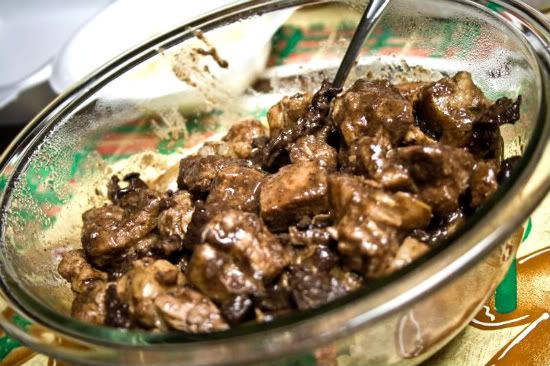Ingredients
3-4 lbs. alimango (crabs)
2 can coconut milk
whole med. sized ginger, julienned
5 pcs. jalapeno pepper, sliced diagonally
1 tbsp. minced garlic
1 bunch scallions, sliced into 1 in. long strips
1 cube Knorr Shrimp or chicken boullion

FILIPINO BEEF STEAK
1 tsp. salt
1 tsp. pepper
1/2 c. sliced onion
6 slices tender steaks
1-2 tbsp. lemon juice
1 tbsp. soy sauce
Cooking oil
Marinate steaks in lemon juice, soy sauce, salt and pepper. Pan fry in about 2 tablespoons of oil. When steaks are cooked remove them from pan onto a serving dish. Add about 2 teaspoons of oil to remaining oil in the same pan and pan fry the onion until tender, yet crisp. Pile on top of steaks. Serve hot.

Lechón (Tagalog: litson and Cebuano: inasal) is the Spanish word for suckling pig. In the Philippines, it connotes a whole roasted pig, litsong baboy. Chicken and beef are also popular. The process of lechón involves the whole pig/piglet, chicken, or cattle/calf being slowly roasted over charcoal.

Dinuguan (also called dinardaraan in Ilocano, or pork blood stew in English) is a Filipino savory stew of blood and meat simmered in a rich, spicy gravy of pig blood, garlic, chili and vinegar. The term dinuguan comes from the word dugo meaning "blood". It is recognizably thick and dark, hence the Westernized euphemism "chocolate meat." It is similar to the Singapore dish pig's organ soup, differing in that it does not contain vegetables and has a characteristically thick gravy. It is frequently considered an unusual or alarming dish to those in Western culture, though it is rather similar to European-style blood sausage, or British black pudding in a saucy stew form. It is perhaps closer in appearance and preparation to the ancient Spartan dish known as black gruel whose primary ingredients were pork, vinegar and blood. Dinuguan is often served with white rice or a Filipino rice cake called puto.


1 comment:
i'm liking these recipes. too bad i suck at cooking.
Post a Comment